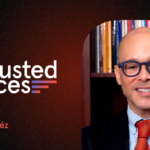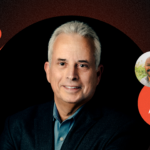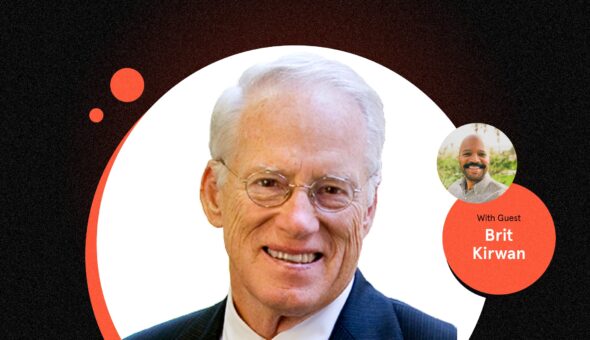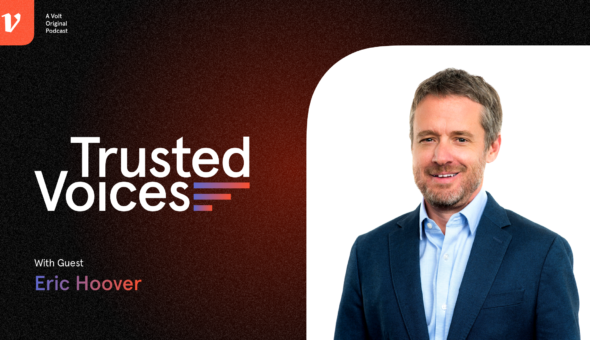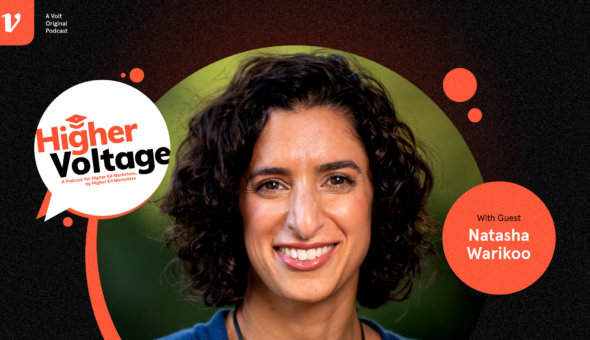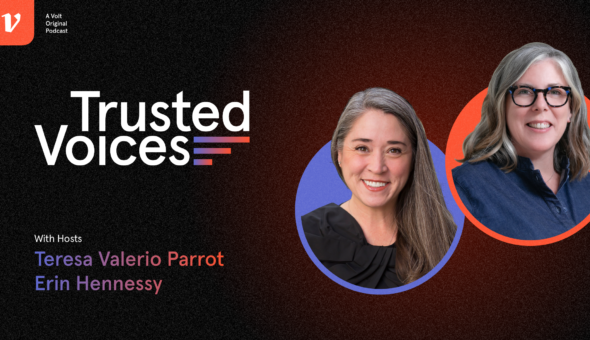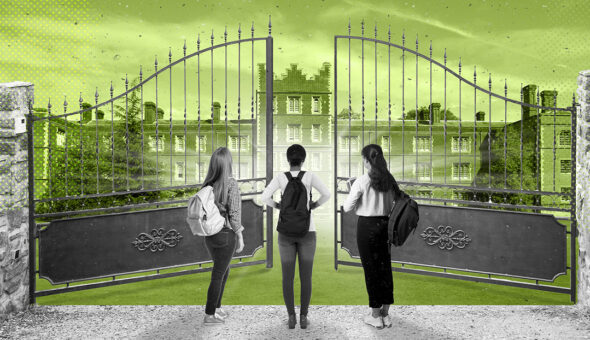Read the full transcript here
Kevin Tyler:
Welcome back to Higher Voltage. I am so thrilled to speak with today’s guest, Catherine Friday of Ernst & Young. Catherine has spent most of her time serving public institutions that design and deliver education. As Ernst & Young’s global education leader, she is responsible for bringing together teams from around the world to support engagements in the departments and ministries of education and higher education, vocational, and K-12 providers.
Catherine has postgraduate qualifications from Monash University, Harvard University, Stanford University, and Cranlana program. She was a trustee and audit committee chair of the Melbourne Olympic Parks Trust, which governs the largest sports and entertainment precinct in the Oceania region. I am so thrilled to welcome you, Catherine Friday to Higher Voltage. Thanks so much for being with us today.
Catherine Friday:
Well, thank you so much, Kevin. It is an absolute thrill to be joining you today.
Kevin Tyler:
I am thrilled to note that you are my very first international guest. I do not know what time it is where you are, but it’s much different than where I am. So thank you for doing all the things that you had to do to make time for this in your busy schedule. I’m intrigued by the report that you have recently released called Why Human-Centered Design is Critical for Universities. Is a treasure trove of insight, thoughtful content around how this can happen, what it means, framing it around people as opposed to technology, and I have tons of questions for you about this report. So before we dive into that, I wanted to make sure that I give you some space to share anything else about you and your background that I did not cover in your bio that you’d like our listeners to know.
Catherine Friday:
Thank you, Kevin. I think you pretty much nailed it. So I’m happy to jump into the questions as soon as you are.
Kevin Tyler:
Right on, right on. Thank you so much. As I’ve mentioned, I love this report. I’m curious if you could tell us how you came up with the idea of framing the idea of technology and transformation around humans rather than the technology itself.
Catherine Friday:
Absolutely. I would love to say it was a spontaneous moment of individual inspiration, but of course good ideas never have that sort of genesis. And in fact, this particular report actually comes from some other work that EY has done in conjunction with the Oxford Saïd Business School, where in sort of 2018-19 time, the firm did some really interesting research across those big tech transformations that succeeded, the very few number that succeed, relative to the vast number that fail.
And when I say fail, I don’t mean that the tech isn’t deployed, but that the tech doesn’t deliver the magic that is promised on the box at the moment that the procurement actually happens. And so we really wanted to understand why is that. And if the tech is good, why doesn’t it actually deliver what companies often, as we know, will spend millions or even billions of dollars, you know, investing to deliver. And so that research in conjunction with Oxford found, big surprise, that the reason a lot of transformations don’t actually succeed is that no one actually ever stops to ask people, what problems do you need solved? What do you actually want out of a good tech experience? If you were designing digital for you, what would that look like? How would this make your life easier? How would you like to be involved in the implementation of this?
And low and behold, for those companies that we surveyed that have had successful tech transformations, and when I say successful, they are two to three hundred percent more likely to have had really good outcomes, the key differentiator was that focus on people. So having humans at the center of their design. So we took that idea and said, wow, this is really interesting. What could this mean and what would this look like if we actually posed this same sort of frame of reference around universities given that universities particularly as they come out of COVID are needing to think hard and deeply and differently about how they do tech transformation too.
In fact, immediately pre-COVID we did some research work with universities and a number of them at that point were saying digital and tech humbug don’t need a bar of it. We have always been here, we have stood as institutions for hundreds if not thousands of years, the students will always come. Change is not something that we like to do and we are staffed by people who are professional skeptics. So we hear your transformation language but we are not buying it. Thank you very much. Then of course lo and behold COVID came along and whether unis wanted to or not they all of a sudden really needed to think hard about how they did tech in the short term and of course increasingly they’re needing to think hard about how they do this for medium and long term as well.
Now as you and I know, Kevin, universities are about to be having intakes of kids who were born the year the iPhone was released in 2007. So these are people who are digital natives in a way that none of us are, when I say us, I’m speaking as someone who was born last century, you know, and, you know, and their expectations and demands of consumer-grade higher education are just native to the way they think about the world.
So I said, yeah, so that was the sort of the genesis of the idea, and that is why we thought if universities are going to succeed at this, and they really need to, because we really need, you know, the current generations, more than any other generation, to have high-quality teaching and learning experiences because the challenges that they are going to be grappling with over, you know, the coming decades are monumental and do actually represent the challenges that are existentially important to humanity. So let’s do our little bit in actually making sure that universities are as well equipped as they can be to support high-quality teaching and learning and tech has got to be part of that so what do they need to be thinking about. So that was what sort of drew us to our original hypothesis that unis need to be thinking about people and they need to be thinking about people differently. So apologies like that, that’s like a 1200-word answer to your original question but that’s where it came from.
Kevin Tyler:
I think, I mean, that background is really helpful because I think that we talk about this often in so many other sectors or parts of the higher ed experience and the need for it to be student-centered or human-centered, whatever the word is person-centered.
Catherine Friday:
Yeah. Yes
Kevin Tyler:
And we always receive in response, some reason why that can’t be but what we have here is 50 pages of a synthesis of reams and reams of data collected from 3000 or so people in students, faculty and staff, professional staff, from eight countries, right, eight geographies. And the theme here is, is that there is a distinct and significant desire for technology to be not just a part of the experience, but ingrained in the experience. It needs to be woven through so that people, so that students understand that not only can they get the education they want the way that they want it but that their institution is invested in the future of what education is going to look like, and they’re prepared to deliver it in those ways. And I find that to be so fascinating, and it’s so relevant, and it’s so now.
This document, to me, feels like something that could be made into a magazine and sent to every CMO at an American institution, all thousand, or 3,000 of them, to every chief marketing officer, because these are the things that people are thinking about the expectations that incoming classes have are so much higher, there’re so much higher about the experience, the quality of the experience, the quality of the education, all of these things. And that is not going to be able to be delivered at that level without technology being involved.
Catherine Friday:
No, absolutely, you’re absolutely right. And that is what we heard time and time again. And as you say, in the research that we did, we engaged with four different cohorts of people across universities.
So we actually asked students, what do you want? What do you value and why? As you said, from eight different regions around the world, we then asked the same thing of teaching staff. We then asked the same thing of research staff. And we then asked the same thing of corporate services staff within universities as well. And not surprisingly, they need different but they were all abundantly clear about what it is they do need and what problems they need help solving so they can actually get on and do what they’re there to do better than they’re able to do it today.
Kevin Tyler:
Oh, so great. I love it. I’m curious, just like at the outset, how did you account for or navigate the differences in policy and funding and politics across the eight geographies for this work? How did you consider that?
Catherine Friday:
So that sort of set the peripheral context of the questions that we asked, but we were actually very particular to ask the exactly the same questions of all of the cohorts that we engaged with because we wanted to be comparing apples with apples at the end of the day, and to make sure that data sets were, they were both quantifiable, but also it made sense to do, you know, compare and contrast within our overall feedback.
The other thing that really mattered to us was that this wasn’t a consideration of policy or even funding. It was about lived human experience with the acknowledgment within the report that how particular providers in particular countries respond to our findings will necessarily be different because of policy and funding mechanisms. However, none of those things actually detract from the lived experience of students and faculty and corporate teams today. And what was actually really interesting to us was that although there were, as I said, there were some peripheral differences in what we found country by country and cohort by cohort.
What was really interesting to us was how much common ground there actually was. And if you’re talking to students in India or Australia or the US or the UK or you know wherever it was we were talking to them fundamentally they were wanting the same things. They might have rated the things that they wanted differently like so when we asked the students to choose you know out of these top 10 things how would you rate them? Some of the ratings might have been a little bit different but you know the top three things were the top three things for everyone which was, which was really really interesting to ask as we went through this process.
Kevin Tyler:
Totally. Can you share just some of the top lines, some of the themes that became immediately apparent through your research and the synthesis of the data?
Catherine Friday:
Yeah, absolutely. What was really obvious to us very early on was that, you know, the thing that students value most out of their higher education experience was high-quality teaching. And they are largely agnostic about whether that teaching is in person or online. But high-quality teaching matters to them very much. And where they were most critical of their providers, it was where that online experience they felt was really letting them down and wasn’t matching their needs and was a long way short of what their expectations had been.
And that was true for students all the way around the world. It didn’t matter, said literally, if we were talking to students in Japan or India or Melbourne or New York, they all said we’re here because we want a high-quality teaching experience. We want access to the best information that we can get and it doesn’t matter if it’s in person or online, we really don’t care. But however it comes at us, it’s got to be awesome and right now it’s not consistently good.
So we then asked them, if you had unlimited funds and you could invest those in any one thing to improve your university experience, what would it be? And again, without fail, the students said it would be improving the digital pedagogy of this university. And if we could do one thing that would make my experience better, it would be actually be teaching our teachers how to use digital tools better because that is the one thing that I really feel is diminishing my experience right now.
Now without sharing any of that data with any of the teachers of course we then asked the teaching faculty if we could do one thing to make your experience of teaching better what would that be and lo and behold they all said the one thing that would make a big difference would be skilling us up in digital pedagogy because we know that’s what our students want and we haven’t got a clue what we’re doing and no one’s telling us how to do it better and that’s really frustrating for all of us. So it seems to me that is a quick win for every provider who’s interested in making a material difference to the experience of their students and their teaching faculty right now. There is a shared need and they’re all saying help us do this better.
Kevin Tyler:
So I think it’s fascinating for, well, lots of reasons. But asking people what they need and then working to deliver it seems to be a really great model of customer service, right? Like, I feel like that’s one of those things that should just be happening.
I think I get lots of surveys from retail organizations, right, that are saying, how do you like to be communicated with? What did you like about this product? They’re constantly collecting information. I’m so curious why the same doesn’t really happen in a higher ed space, right? This feels like, this feels revolutionary, but in actuality, it’s not really, right?
Catherine Friday:
No, no it’s not and you’re right, in other sectors and other industries this happens all the time and it is a routine part of engaging with clients or customers. Now of course the whole notion of students as customers that in itself is revolutionary in some universities and for so long a number of them particularly the global elites have had and been able to have the mindset that we are here and anyone who comes here is privileged to be here.
And so we can do what we do and we can be who we are and that will just need to be okay. But of course the whole nature of the delivery of education, not just higher ed but all education, is changing.
Kevin Tyler:
Sure.
Catherine Friday:
And it is increasingly possible for students to choose to access high-quality education content from any provider on the planet as and when they want to. So unis really need to be thinking long and hard and differently about what their value proposition is to students. And why should students actually choose them over all of the other claims, potential claims on their time and on their dollars? So a number of universities are starting to make this transition to thinking about students as customers, but it is a challenge for some of them. Regardless of how you see students though, of course students have sort of a customer experience journey or a customer experience map if I can call it that as does someone who is consuming any good or service from any provider.
So there is that moment of first awareness that your good or service even exists through to you know the moment of them engaging with you learning about you and you know and you know consuming that good or service you know again whatever it is. Now we know, having done a lot of journey mapping over higher education life cycles and student journeys through universities, that there are moments that universities do well, but there are many more moments that universities do badly. And those are moments therefore, that can cause student attrition at quite high rates. Where if they did a little bit differently, it would make a huge difference to a student’s sense of belonging and engagement with their university as well. So for any student, there is that moment that they first click on your webpage, or they first see something on TikTok about you, or someone first mentions you in passing, to the time they actually then narrow you down through their own process, as to wanting to make an application to you, to understand more about you, and to ideally both complete and then finish their degree or studies with you.
And there are so many points of potential friction or loss of positive experience through that, that leading universities are seeking to lean in and actually understand what is it that makes an experience here good, where are the points of friction and what do students want? And again, that is something that really, we really sought to unpack as part of our study as well. Where are universities losing students? And obviously there is a massive financial implication of that. Where for the want of a small app, for instance, they may be able to engage differently and they may be able to use data analytics to say, hey, we’ve noticed that you haven’t been to the last three or four tutorials, is everything okay? Would you like to book a meeting with someone? Can we step in and support you? You know, or your last essay was a bit late. Can we have a chat about that with you? Rather than not using any of the available tech and students feeling really disconnected and disengaged and disenchanted and potentially dropping out of the system entirely.
And of course, that’s particularly true for students who are first in their family to attend university, or those who often come from remote or regional areas or low SES areas. And if this whole experience is a bit new and a bit overwhelming for them to begin with, the want of that sort of more personalized interaction can really make a big difference between them staying or them leaving.
Kevin Tyler:
I think it’s what you’ve just shared and makes me think of several stories in my head around higher ed marketing, how messages are amplified and distributed. And this idea, this research and this document that you’ve created really speaks to the idea that it’s not just about content, it’s not just about message, it’s also about how I interact with the message, how I absorb, how I experience the content, that is just as important. That is just as much part of your marketing effort as the content itself because these incoming classes are paying attention to a lot more things that we might, as marketers, might not even think about in experience, especially digital. The digital experience is one of those things.
So if you’re using words like innovation and forward and future thinking and solving the world’s the problems that, you know, don’t exist yet and your website is terrible and the experience is not great and the lectures are only just on that site and it’s it breaks up and it’s just not high quality, then I have a hard time believing that you’re innovative. I have a hard time believing that you’re future-focused and that you’re answering the problems that don’t exist yet, right? And this is not like a slight on institutions. It’s just like one of those things that I think people forget that it’s not just the message, it’s also how well the messenger works.
Catherine Friday:
That is so true, Kevin. And it is one of the things that we asked students as part of our research was pretty much, are you getting the experience from your university that you were promised, that you thought you were signing up for? Which we thought was a pretty important question to ask.
And as you said, not one that universities often ask, but it’s an unusual relationship that universities have with their students because it’s one of the few relationships that we have with any provider where we are forking out a lot of money but don’t actually have any recourse if we don’t get the experience we think we’re paying for or we’re signing up for. So we thought that was an interesting question to ask and what we found was that around 21-22% of students globally were or are really dissatisfied with the experience that they’re having and you might say well you know the good news there is around 79% are, you know, happy to very happy with the experience they’re having that’s great
But in any other sector, if you found out that 20% of your consumers were deeply dissatisfied with the vast chunks of money that they were forking out and the opportunity cost of their time, you’d be thinking we can probably do better here.
And you’d also be thinking at the providers down that, you know, the far left end of the bell curve thinking, perhaps their days are numbered. And maybe if you were one of the providers down at that far, you know, left side of the bell curve, you’d be thinking, I need to get my skates on and there are things that we need to do better in a hurry here. Because students have a lot of choice. And if we are not clear about our value proposition, and if we are not delivering that experience to our students, do we actually deserve to still be on the block?
Kevin Tyler:
Mm. Speak on it, Catherine Friday. Yes. Exactly right.
Catherine Friday:
[Laughter]
Kevin Tyler:
I’m curious if any of the findings from your research were particularly surprising for any reason, from any geography, any topic area, was there anything that made you and your team just kind of perk up like, oh my goodness?
Catherine Friday:
Well, I think that one of the things that did surprise me, or I think surprised the whole of the research team who was involved with this, was actually how globally consistent the findings were. And so that suggested to us that there is no single geography that has nailed this, but it also was really, really interesting that I guess what it showed us is that there are pockets of excellence in all of the countries that we looked at as well. I mean, absolutely there were some regional variations to the findings that we thought, and we do in fact have regional cuts of the reports and the data sets. So, as a for instance, we found that in Australia, more students are juggling work with study than is true for the national average.
So in Australia, 75% of students are also working full or part-time in addition to carrying full-time study loads. So that suggests something about how forward-looking universities need to think about delivering content to students in this particular corner of the world.
Correspondingly, when we were looking at other GOs, like, in fact, so, you know, a unique data point around the US is that, you know, unlike every other surveyed country, course offering in the US was not the top driver of university selection, but in fact, location and cost were the top considerations and access to scholarships was a key consideration ahead of the courses that students were actually enrolling in.
We also found in the US that as it’s a more digitally mature market, on the whole US students are happier than the global average with the quality of the online learning experience that they’re getting. But with that said, they too would really focus in investment on teacher training and student support for more effective digital learning.
Another regional variant was that Japan was the only country where students rated value for money as really high on importance in their experience and they rated that as highly as the quality of teaching, whereas a straight quality of teaching was how everyone else ranked what mattered to them as part of their higher ed experiences.
So there were sort of those discrete outliers, sort of country-by-country that we looked at, but overall, the thing that did surprise us was just the commonality of experiences that students are having, regardless of what country in the world we looked at. And even within country, because we looked at both international students who are studying in country as well. So was their experience the same as domestic students? And again, it was. So it kind of didn’t really matter how we cut it or diced it, there was just a lot of common ground.
Kevin Tyler:
That’s fascinating to me. And like this desire, this stated desire that we now have this document that EY has created kind of lays the groundwork, right? I think that I feel like there should be like, institutions at least in America do strategic plans all of the time. And I feel like if strategic plans and US institutions were grounded in things like digital transformation, as opposed to like the other kinds of things that render a document like that kind of unusable a lot of times, just because it’s unwieldy and it’s too big and it sits on a shelf and then you never really see it again. I feel like this is a really novel approach to developing strategic plans for institutions because we know that this is what students want. And so what is the strategy to get an institution from where it is now to where it needs to be to serve the needs of its students? And I think this is a really great kind of primary document to reference in building that kind of content.
Earlier this year in January, I’m gonna read a short paragraph from an article that I was looking for as a result of reviewing the research and the document that you and your team have developed here. And the title of the direction of the article is How Power 5 Universities Spend So Much More Per Athlete Than They Do For Other Full-Time Students. And so the paragraph I wanna read is just this: “To put these ratios [so they measured them in ratios] into three examples using dollars. Louisiana State University, so LSU, spent $381,724 per student athlete, which is 10.4 times what it expended on its average full-time equivalent student, which that dollar amount was $36,000 and some change. University of Arkansas was $315,000 versus $34,000. University of Alabama, $274,000 and some change versus 30,000-ish.”
And so the point I’m getting to here is that if we can make these athletic transformations, we have all this investment that we’re willing to make into the student-athlete, why are we not making the same kinds of investments in our regular full-time student educational experience? Now I’m not asking you to answer that, but it’s just something that came to mind when we think about investments and transformation and how we start to get to a more student-centered, human-centered approach to delivering education that we seem to have found out in athletics.
Catherine Friday:
It’s a really, really interesting question, Kevin, and I don’t have a neat answer for it. I think what would be really interesting, and I don’t know the answer to this, but what would be really interesting would be to understand why those universities have made those choices and what do they see their value proposition as being, that those are the investments that they’re seeking to make and what sort of return are they actually getting on those investments? Is that potentially tied up with scholarships? I don’t know. I don’t know the answer to that.
But I guess the question that it raises in my mind is, is making those sorts of investments actually improving equitable access to high quality education for broader cohorts of students? Is it lifting or uplifting the quality of teaching and learning experience that most students have? And is it providing for the long-term sustainability of, you know, of the institution as well?
And there may be really solid and sound answers to all of those questions and I don’t know what they are, but they’re questions that immediately come to mind for me and I think if I were being asked to support some strategy setting work that a university was doing, I would certainly be going back to those first principle questions of who are we and who are we here to serve.
Kevin Tyler:
Yes.
Catherine Friday:
And what is our value proposition around that and what experience do we want our teachers, our students and our researchers to have and how do we differentially invest in those things? And then there is, I guess the related question around our obligations around community building and society building as part of that.
Kevin Tyler:
Totally.
Catherine Friday:
And so, yeah, and those may all be questions that are on the agenda of the boards and the chairs of those institutions. I don’t know that. Certainly, I think one of the things that does excite me about digital education done well is that it does have the capacity to put high-quality teaching and learning into the hands of students from your own institution, but potentially students right around the world, if that is your choice.
And so when we think about the UN Sustainable Development Goals, obviously goal number four is the one related to making sure that all the world’s learners have access to high-quality teaching and learning. I think the education goal is the one that we might actually be able to achieve within our lifetimes and it will be through digital education done well.
And so universities actually have the opportunity to be leaning hard into that and to thinking you know and be thinking really cleverly about how they make their content available absolutely to their own students but in new and different ways to other students from all around the world as well. And if they spent on their digital backbones, the same as what they spend on one building, their potential for growth and change and transformation for their students and for their staff would be absolutely transformative and market-making.
Kevin Tyler:
Totally. I could not agree with you more, Catherine. I think what I think about, what we know about higher ed, at least in America, is that there are pockets of very, very technologically advanced departments. There are, it exists in higher ed today, but it might be reserved for the athletes. It might be reserved for research only. It might be reserved for some other, some corporate partner, whatever it is.
But what I hear you saying is that democratizing the access to high-quality education via technology is going to take far more investment, strategy, thought, to make it what students need. And so, I only bring up that Forbes article because I think about the things like the athletic centers I’ve seen that are so technologically advanced. And so we know that it’s possible. We know that delivering a high-quality experience is possible through technology. And why can’t we shift that over to the full-time education experience? Go ahead. I’m sorry.
Catherine Friday:
I was going to say the, in fact, the athletics example is a really interesting one. Because when you think about the amount of data that is collected about the performance of individual athletes and the number of tools that are used and the richness of the data, the data sets that are then mined to support each individual athlete to maximize their potential.
The exact same sort of technology can be used to support each individual student to reach their maximum potential as well and provide much more bespoke and personalized teaching and learning trajectories and journeys as well. And that data is already there. You know, each university every day is gathering data points around every single student in every single course. And so again, some universities are already starting to do this, but if we gather that information and start to use predictive analytics to support personalized learning trajectories and put that same sort of investment into each individual student, then they have, then each person who passes through university is enriched in the same way through their life trajectory based on their education as athletes are based on that, that particular talent set that they have as well. So the tech is there, the tools are there, the data is there, the predictive analytics suites are all there. We just need to repurpose them and it can be done at scale really easily.
Kevin Tyler:
Oh, I love this conversation. This is so great to me. I am curious. So this is a relatively new report. I understand that and the research is fairly fresh, but I’m wondering if there have been any pockets of response as a result of the research and like, has it been positive? Has it like, what has that looked like?
Catherine Friday:
So the sector response to it has been very, very strong so far. That said, as with all things, you hear loudly from those who really like it, and you hear loudly from the few that don’t as well. But overwhelmingly, the feedback that we’ve had has been positive. And I think the particular tells for me about that, that we have had universities from right around the world actually get in touch with us and say, hey, we loved what you did. We want to know more about it. Can we both use the report? And obviously, the answer is yes. But can we see the data sets? Can we talk to you more about it? Because we actually want to revisit our strategy based on some of the thinking that you’ve shared. And in fact, it’s a really great time for us to be having this discussion today, Kevin, and I know it’s serendipitous, but it’s worked really well because we’re about to actually launch volume two of this report.
So the report that you and I are talking about today if you like, is sort of framed. What is it that students want, what is it that the people at the center of universities want? And the companion volume that’s being launched in March is, and how do universities actually deliver that? So what are the psychological and change management and leadership attributes that universities need to be proactively managing in order to achieve those sorts of changes?
So there will be sort of noted that the two volumes that are there, and again, some of the universities that we engaged with as part of the research who knew that volume two was coming have reached out in advance to say, we want embargoed copies, hand them over now. We promise not to take them to the media, but we really need it because we’re running a strategy session this week. And again, I always take that as a really good sign when the sector is actually saying, you’ve got research, hand it over, we want it. So, yeah.
Kevin Tyler:
Totally, totally. And not just we want it, we want it in this very important critical time of planning for the future so that we can incorporate some of the thinking that you’re providing into what this is. And so that response is so encouraging to me. I hope that like more, I hope American institutions are interested in the data as well. And I hope that folks who are listening to this will reach out to you, will have all of your information about the report and the data on our episode page, but I hope that you hear more from, you know, the 50 states around, you know, how this is working, because while this is a global study, there are a lot of information that is globally applicable, including to institutions in the United States.
Catherine Friday:
And I would welcome that, Kevin, would love to hear from anyone and also to make available whoever wants it, the specific US slice of the data as well.
Kevin Tyler:
Oh, I would definitely love to see that if you don’t mind. Definitely.
Catherine Friday:
Yeah, happy to share it. Yeah.
Kevin Tyler:
So I love that you’ve had this response of institutions and industries and geographies, not industries, institutions and geographies reach out for more access to this information. I’m curious if you are aware of any new decisions that institutions have been making as a result of this work. Again, knowing that it’s pretty new.
Catherine Friday:
Yeah and no I’m not aware of new decisions that have been taken yet but as you say we only released it in November and then there was well Thanksgiving and Christmas and holidays and stuff and of course in my part of the world in Australia sort of the university’s kind of shut down for our summer break so people are just kind of back on deck now-ish. So I think the sort of again the real the real tell will be what happens in the next six months particularly once the second volume is released.
Kevin Tyler:
Totally, I can’t wait for that. I have not been this excited for data in my entire life.
Catherine Friday:
I will be glad to share.
Kevin Tyler:
So like, thank you. I mean, I don’t know, I’m gonna ask this question. I’m not sure how comfortable you are with it. It’s on the, you know, it’s on our prep doc, but based on what you’ve seen, read, researched in this work, are there countries that you feel are best positioned to achieve human-centered transformation before others, and if so, why? What’s different about their infrastructure?
Catherine Friday:
Yeah, so I think the question of infrastructure is actually one of the most important pieces here because it’s all very well to have a digital strategy, but if your teams and if your people don’t have access to cheap, reliable Wi-Fi or broadband technologies and if they don’t have devices, then the strategy flies out the window really, really fast.
So for me, it would be those countries or providers who are aware of that and make sure that there is no digital divide between those who have that sort of access and infrastructure support and those who don’t and work really hard to level the playing field there. And so it may be that we actually see some surprises in the countries that emerged as mature providers of high-quality digital teaching and learning ahead of others.
I think within countries like yours and mine, Kevin, we would expect to see a rapid uptake in highly urbanized and wealthy areas and there will then be a tail, sadly, into other parts of the country. Meanwhile, when you look at particular parts of Central Europe or even Africa, where governments have invested in universal access to devices and universal access to broadband. I can see that those sorts of countries could well leapfrog the rest of us in terms of having faster universal access to high-quality digitally provided teaching and learning.
So it may well be that a lot of the production of content continues to come out of the traditional areas of provision. So US, Canada, UK, Oceania, as a for instance, for high-quality content in the English language. But it may well be that is increasingly consumed off our shores by people who are well supported with digital, a better digital infrastructure than we may have in our own countries.
Kevin Tyler:
Fascinating. I have one more question for you that I like to ask every guest who joins me on this show. But before I ask that, I want to ask you if there’s anything else about the report that you think is really important for our listeners to hear or know about that I have not asked you about.
Catherine Friday:
No, thank you so much, Kevin. Look, I don’t think there is. I think it’s been a great conversation. And as you said, the report is there and freely available to whoever may be interested in taking a peek at it.
Kevin Tyler:
Totally. I would encourage everyone who’s listening to this to take a look at this document, this report, because it has so many thoughtful ways to think about how we can reframe, how we deliver education in a way that is current and relevant and meets the needs of the students as opposed to how we, as an industry, think it needs to be delivered. It completely centers the human. And I think that is the most beautiful part about all of this is you ask what is needed, here’s what is needed, and now there is no excuse, right? Like there’s just no other way to go about delivering high-quality education through technology because we have all the data right here.
Catherine Friday:
Absolutely.
Kevin Tyler:
So my last question is, what do you think the future of higher ed looks like in about 10 years, 20 years, however, whatever length of time you want to choose?
Catherine Friday:
So I know I’ll get the answer wrong, but because it will change in ways I cannot imagine between now and then, but based on what I know today, I think it will become far more personalized. And rather than universities just saying, this is our degree structure, if you are enrolled here, this is what you must study, I think there will be a lot more opportunities for students to say, I actually want to do a couple of modules from here and then a micro-credential from that over there and then I actually want to do some offshore and then I actually want to do some workplace or work integrated learning and get some academic credit for that because the future that I am facing into is one that the traditional degree structure simply does not equip me for.
And I think that we will quite quickly see our governments and tertiary regulators around the world seeing that and acknowledging it. And effectively creating digital passports for skills and teaching and learning that recognize all of the moments and styles and experiences of teaching and learning that students have had. And stepping away from only accepting the traditional degree with the traditional, you know degree or diploma at the end of it, as the only recognized or credible acknowledgment of a high-quality teaching and learning experience.
Now, when you think about it today the higher education institutions basically have the monopoly on giving out degrees and diplomas and so effectively what I see is that monopoly being challenged and it ultimately being challenged by students who will say, I see what you’re selling and I don’t actually want it. I actually want maybe some of what you’ve got but some of what the guy down the road is selling as well and so that’s what I’m going to have.
Kevin Tyler:
Oh my God, that is a fantastic vision. And one that has not been a response we’ve had on this, on the show before. So I really appreciate that. It’s a very unique idea and I think it’s compelling. And I hope part of that is what happens. I think that’s what, that’s what people will are to build on their own. And I think you’re exactly right that the idea of a traditional higher ed, higher education experience is being challenged every single day. And if the industry doesn’t get on board globally, not just here, but globally, then we will, I don’t think it’ll be a good thing if they don’t get on board with that.
Catherine Friday:
Yeah. Yep, completely agree with you, Kevin.
Kevin Tyler:
Catherine Friday, I’ve had so much fun chatting with you. I’ve had so much fun preparing for this conversation. The information that is included in your report, why human-centered design is critical for universities is critical for every person who’s working in leadership on a campus. It is critical to review this information, to take it to your leadership and say, we need to make moves. We need to make investments where we can to make the digital education experience more human-centered, but also just make the educational experience way more human-centered. So thank you for doing this work. Thank you for joining me on this, for this conversation. And I’d like to reserve the right to have you back when part two, it gets released. So if you want to talk about that as well.
Catherine Friday:
Oh, I would love to. Thank you so much. And it’s been it’s been an absolute pleasure. Enjoy. Thank you.
Kevin Tyler:
Awesome. Thank you so much.
Catherine Friday:
My pleasure.

